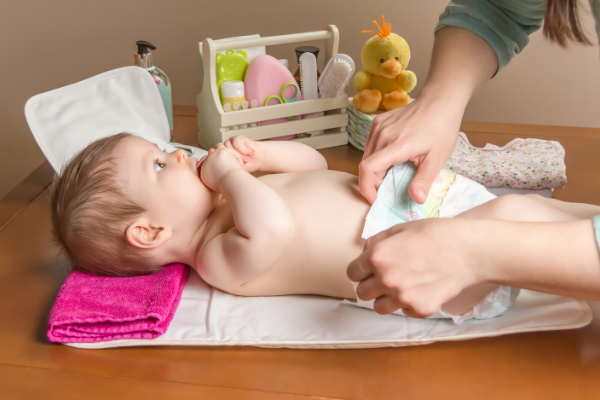
If your little one is suffering from diaper rash, you probably on the hunt for natural diaper rash remedies that are both non-toxic and effective.
What Is a Diaper Rash?
Diaper rash is a common problem for many babies. It’s when the skin on your baby’s bottom is red and inflamed – appearing as red patches or bumps that are painful and sensitive to the touch.
There are two types of diaper rash – diaper dermatitis and yeast rashes.
- Diaper Dermatitis is the most common and it’s caused by your baby’s diaper or what’s in it. It looks like small red bumps that, if left untreated, can bleed and become infected.
- Yeast Rashes look much like diaper dermatitis, but with one big difference – white, fluid-filled blisters. These well-defined blisters are white and appear scaly. They often have raised edges. If they pop, they can become infected.
Diaper rash can be mild or quite severe, and may be caused by any number of reasons.
7 Common Causes of Diaper Rashes
When it comes to diaper rashes, there are 7 common causes. Your little one may be:
- Experiencing diarrhea or has a cold
- Taking antibiotics
- Moving around a lot causing friction and chafing
- Transitioning from baby food to solid foods
- Experiencing an allergic reaction to their diapers or wipes or products such as soap or laundry detergent
- Sitting in a wet or soiled diaper for too long
- Sleeping through the night, which means fewer diaper changes
4 Diaper Rash Signs and Symptoms
If you’re still unsure if your little one has a diaper rash, keep an eye out for these 4 signs and symptoms.
- When your baby is urinating or having a bowel movement they are visibly upset.
- Red, tender-looking skin either on your baby’s buttocks, thighs, or genitals.
- Your baby doesn’t like their skin touched when changing their diaper.
- Your baby’s skin is bleeding or oozing.
3 Tips For Preventing Diaper Rash
Remember these 3 tips to help prevent diaper rash:
- Change them frequently – The easiest way to prevent and treat diaper rash is to keep your baby dry. That means changing them as soon as their diaper is wet or soiled.
- Be gentle – Always make sure to be gentle when changing your baby’s diaper – pat, don’t rub the skin.
- Let it dry – After changing their diaper, allow time for the skin to dry completely to help with healing. You can even let them go without a diaper for a period of time to ensure the area stays dry.
7 Natural Diaper Rash Remedies
With more frequent diaper changes and the right remedies, you can help clear up your baby’s diaper rash. Take a look at these 7 natural diaper rash remedies.
- Pure Aloe Vera Juice – Wet or soiled diapers can cause your baby’s skin to become too alkaline. Pure aloe vera juice helps to cool and heal the skin. Add 2 tablespoons of pure aloe vera juice to a bowl of lukewarm water. Soak their bottom in the solution for about ten minutes. Pat the skin with a towel and then air dry to ensure that the skin dries completely. Follow up with a natural moisturizing cream or salve. You can apply it directly to their skin with your fingers or with a clean cloth.
- Coconut Oil with Lavender Essential Oil – Coconut oil has lots of therapeutic compounds and is easy to spread on baby’s skin when it’s at room temperature. Coconut oil helps to kill bacteria, speeds the healing process, and also provides moisture. Lavender oil provides another layer of hydration and helps to regenerate skin tissue. Start by melting ¼ cup of coconut oil and then add 1 drop of organic, 100% pure lavender oil. Mix well and store in a glass jar to spread on your baby’s skin to prevent or treat diaper rash.
- Olive Oil – Olive oil helps to moisturize and soothe rough skin. It creates a barrier to help the skin heal. Make sure to use it sparingly to ensure that your baby’s diaper remains absorbent.
- Apple Cider Vinegar – Wet diapers can cause your baby’s skin to be too alkaline, which causes dryness and irritation. Apple cider vinegar can help. Pour lukewarm water into a bowl and add 2 tablespoons of apple cider vinegar. Soak baby’s bottom in the water/vinegar solution for ten minutes. Rinse, and then pat their skin dry or allow it to air dry. It’s important to follow up with a natural moisturizing cream or salve.
- Non-Nano Zinc Oxide – This easy-to-use remedy helps to protect healing skin. It can be found in many diaper creams, however it’s important to make sure you’re using non-nano zinc oxide since the particles are larger and won’t penetrate the skin. Make your own by combining zinc oxide powder with either shea butter or coconut oil.
- Baking Soda – Baking soda is highly alkaline. This means it will help neutralize the acidity and any bacteria from a diaper rash. Take 2 tablespoons of baking soda and add it to lukewarm water. Soak their bottom in the solution for about 3 minutes. You can also apply the mixture to their skin using a soft cloth.
- Natural or Organic Diaper Cream – There are some great natural and organic diaper cream options. Diaper creams are quick and easy to apply and don’t require any mixing. Look for skin-soothing ingredients such as aloe vera, chamomile essential oil, lavender essential oil, non-nano zinc oxide, shea butter, and echinacea extract.
As a parent, it is important to find the remedy that works best for you and your baby. Just remember that a little TLC goes a long way.
If you’re not seeing any change or things are getting worse after trying these natural diaper rash remedies, be sure to reach out to your baby’s pediatrician.
